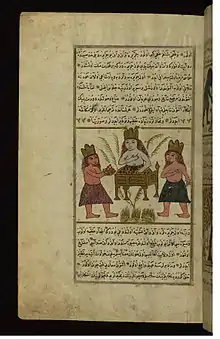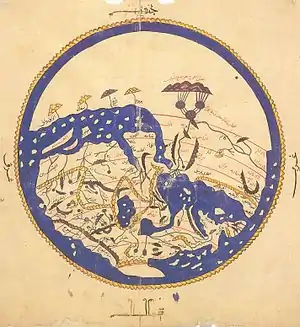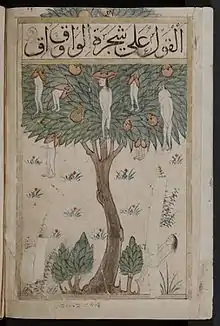al-Wakwak
Al-Wakwak (Arabic: ٱلْوَاق وَاق al-Wāq Wāq), also spelled al-Waq Waq, Wak al-Wak or just Wak Wak, is the name of an island, or possibly more than one island, in medieval Arabic geographical and imaginative literature.[1]

Identification with civilisations
Wakwak is referred to in a number of sources; it is generally an island far away.
In Arab versions, the famous island of Waq-Waq is located in the sea of China. The island is ruled by a queen and the population is only female: it is usually illustrated in al-Qazvini manuscripts of the Wonders of Creation showing the queen surrounded by her female attendants.[2]
Ibn Khordadbeh mentions Waqwaq twice: "East of China are the lands of Waqwaq, which are so rich in gold that the inhabitants make the chains for their dogs and the collars for their monkeys of this metal. They manufacture tunics woven with gold. Excellent ebony wood is found there. And again: Gold and ebony are exported from Waqwaq".[3] Suma Oriental of Tome Pires mentioned that the people of Java has "many fine hounds with collars and rings of gold and silver", matching Ibn Khordadbeh description of Waqwaq.[4]:176 Michael Jan de Goeje offered an etymology that interpreted it as a rendering of a Cantonese name for Japan. Gabriel Ferrand identified it with Madagascar, Sumatra or Indonesia.[3] Tom Hoogervorst argued that the Malagasy word vahoak, meaning "people, clan, tribe", is derived from the Malay word awak-awak, "people, crew". Ann Kumar agrees with Hoogervorst, and identifies Wakwak as Indonesia, and implies the possibility of ancient Indonesian attack on Africa's east coast.[5]:110

The 10th century Arab account Ajayeb al-Hind (Marvels of India) gives an account of invasion in Africa by people called Wakwak or Waqwaq,[5]:110 probably the Malay people of Srivijaya or Javanese people of Medang kingdom,[6]:39 in 945-946 CE. They arrived in the coast of Tanganyika and Mozambique with 1000 boats and attempted to take the citadel of Qanbaloh, though eventually failed. The reason of the attack is because that place had goods suitable for their country and for China, such as ivory, tortoise shells, panther skins, and ambergris, and also because they wanted slaves from the Bantu peoples (called Zeng or Zenj by Arabs, Jenggi by Javanese).[7] According to Waharu IV inscription (931 AD) and Garaman inscription (1053 AD),[8][9] the Medang kingdom and Airlangga's era Kahuripan kingdom (1000-1049 AD) of Java experienced a long prosperity so that it needed a lot of manpower, especially to bring crops, packings, and send them to ports. Labor was imported from Jenggi (Zanzibar), and possibly Pujut (Australia), and Bondan (Papua).[6]:73 According to Naerssen, they arrived in Java by trading (bought by merchants) or being taken prisoner during a war and then made slaves.[10]
The full transcription of the Wakwak account in Ajayeb al-Hind is as follows:
"Ja'far bin Rasid, known under the name of Ibn Lakis, a noted pilot for the gold countries, has related to me some extraordinary matters concerning the Wakwak of which he was himself witness. In the year 334 A.H. (A.D. 945) the Wakwak set out with a thousand ships to launch a determined attack upon the town of Kanbaloh. But they were unable to capture it, for the town was strongly fortified and was surrounded by an arm of the sea, in the midst of which Kanbaloh rose like a fortress. People of the country, with whom the intruders held parley, demanded why they had come to Kanbaloh rather than to any other place; they replied that it was because the country possessed merchandise of value in the Wakwak country and in China, such as ivory, tortoise shell, panther skins and ambergris, and also because they wanted to obtain some of the Zenj people, who, being strong men, are able to stand heavy labour. Their voyage, said they, had lasted a year. They had pillaged several islands at six days' sail from Kanbaloh, and afterwards many towns and villages of the Zenjs in the Sofala country, without reckoning we know not what. If the story told by these people be true in speaking of a voyage of a year's duration, this proves," says the writer, "that Ibn Lakis is right when he maintains that the Wakwak Islands are situated opposite to China." - Buzurg Ibn Shahriyar of Ramhormuz, Ajaib al-Hind[11]:307–308
The writer says that the inhabitants of Waqwaq are numerous in number, with some of them resemble the Turks in appearance. They are the most industrious of all Allah’s creatures but is said to be treacherous, cunning and lying.[5]:110
The waqwaq tree

Tongdian by Du Huan mentions an Arab account of a tree growing little children.
In the Kitab al-Bulhan, the painting titled the ‘Tree of Waq Waq’ is rather extraordinary because it illustrates the way in which the all-female population reproduces and self-perpetuates. Female figures grow from the tree as if they mature like fruit until they are ripened and they drop to the ground emitting a cry that sounds like 'Waq Waq!'[2]
An Andalusi versions mentions beautiful women as the fruit of the tree.[3]
Mauny thinks this may be the pandanus tree, called Bakkuwan by the Bataks of Indonesia and grown in Madagascar where it is called Vakwa.[5]
See also
- Zabag, another Arabic word for a kingdom or an island in Indonesia
- Jinmenju, a strange Japanese tree in Toriyama Sekien's Konjaku Hyakki Shūi.
- Nariphon, a tree in Buddhist mythology that bears fruit in the shape of young female creatures.
- Zaqqum, a tree in Jahannam, the fruits of which are shaped like the heads of devils.
References
- G. R. Tibbetts; Shawkat M. Toorawa; G. Ferrand; G.S.P. Freeman-Grenville (22 August 2013). "Wāḳwāḳ". In P. Bearman; Th. Bianquis; C.E. Bosworth; E. van Donzel; W.P. Heinrichs (eds.). Encyclopaedia of Islam (Second ed.). Brill Online.
- The ‘Book of Surprises’ (Kitab al-bulhan) of the Bodleian Library.
- Saudi Aramco World: The Seas of Sindbad, Paul Lunde.
- Pires, Tome (1944). The Suma oriental of Tomé Pires : an account of the East, from the Red Sea to Japan, written in Malacca and India in 1512-1515 ; and, the book of Francisco Rodrigues, rutter of a voyage in the Red Sea, nautical rules, almanack and maps, written and drawn in the East before 1515. London: The Hakluyt Society. ISBN 9784000085052.
- Kumar, Ann. (1993). 'Dominion Over Palm and Pine: Early Indonesia’s Maritime Reach', in Anthony Reid (ed.), Anthony Reid and the Study of the Southeast Asian Past (Sigapore: Institute of Southeast Asian Studies), 101-122.
- Nugroho, Irawan Djoko (2011). Majapahit Peradaban Maritim. Suluh Nuswantara Bakti. ISBN 9786029346008.
- Reid, Anthony (2012). Anthony Reid and the Study of the Southeast Asian Past. Institute of Southeast Asian Studies. ISBN 978-9814311960.
- Nastiti (2003), in Ani Triastanti, 2007, p. 39.
- Nastiti (2003), in Ani Triastanti, 2007, p. 34.
- Kartikaningsih (1992). p. 42, in Ani Triastanti (2007), p. 34.
- Hornell, James (December 1934). "Indonesian Influence on East African Culture". The Journal of the Royal Anthropological Institute of Great Britain and Ireland. 64: 305–332 – via JSTOR.
Further reading
- Triastanti, Ani. Perdagangan Internasional pada Masa Jawa Kuno; Tinjauan Terhadap Data Tertulis Abad X-XII. Essay of Faculty of Cultural Studies. Gadjah Mada University of Yogyakarta, 2007.